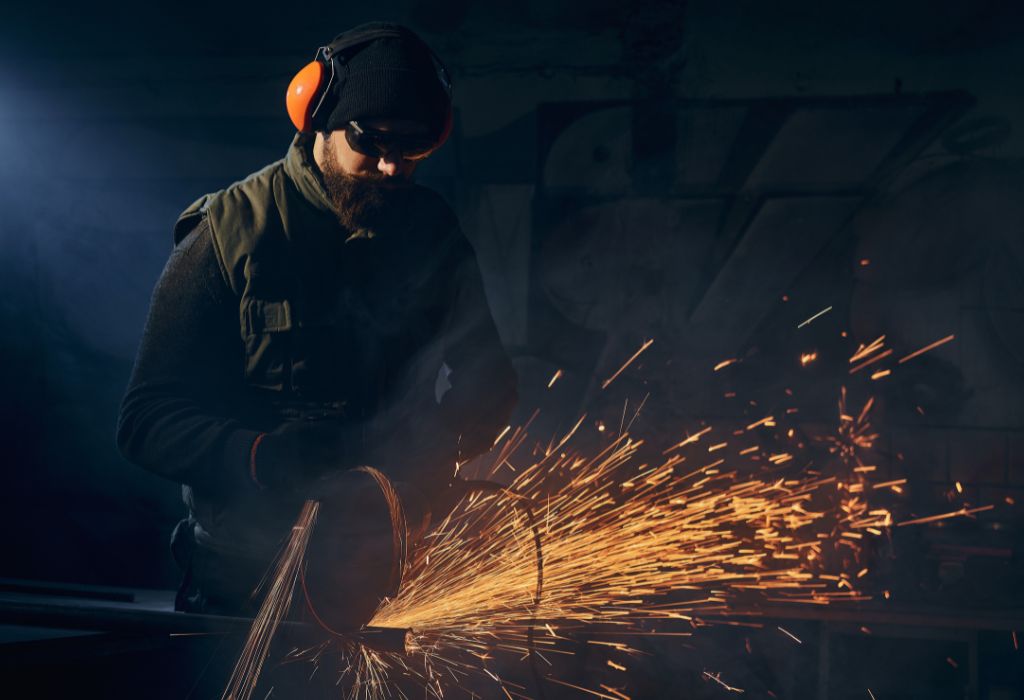A student wipes off their hood as the last practice bead cools, wondering what the first paycheck will look like.
How much does a beginner welder make on day one is one of the most common questions for anyone entering the trade.
The numbers can feel confusing. Job boards show hourly rates, some schools advertise annual salaries, and experienced welders talk about overtime and per diem that change everything.
Understanding the real starting range is key for setting expectations.
Across the United States, the median welder wage is about $51,000 per year according to the U.S. Bureau of Labor Statistics (BLS).
Beginners usually start just below that line, with averages around $19 to $25 per hour. That adds up to $40,000–$52,000 annually before bonuses and overtime.
Total compensation is what really counts. Travel stipends, night-shift differentials, and union contracts often boost first-year pay beyond what a simple hourly rate suggests.
The right mix of certifications and assignments can turn entry-level into career-level income in just months.
This guide breaks down what beginner welders earn, what drives those numbers, and how to boost pay quickly in 2025.
The Short Answer: How Much Does a Beginner Welder Make?

A beginner welder in 2025 can expect to earn $18–$26 per hour, which equals about $37,000–$54,000 per year on a 40-hour week. The variation depends on region, employer, and the type of work assigned.
National data backs this up. The BLS median for all welders is $51,000 annually, so beginners fall just below that midpoint. Job board averages, such as those from ZipRecruiter, place entry-level welders around $22 per hour.
Q&A:
What is the typical hourly rate for new welders?
Between $19 and $25 per hour in many regions.
What does that mean annually?
About $40,000 to $52,000 per year before OT.
Do some beginners exceed $60,000?
Yes, with overtime, per diem, or specialty work.
Are benefits included in this pay?
No, most figures exclude healthcare, retirement, and tool allowances.
How fast can pay rise?
Many welders get raises within the first 6–18 months after new certifications.
What Drives Entry-Level Pay: Location, Industry, and Shift
Geography plays a big role. Welders in major metros or energy hubs usually earn more than those in small-town fabrication shops. Cost of living also impacts starting wages.
Industry is another factor. Construction, pipeline, and heavy industrial projects often pay more than light fabrication or repair shops. Shift assignments, such as nights or weekends, also add differentials.
Q&A:
Do big cities pay beginners more?
Yes, demand and cost of living push rates higher.
Which industries pay the most?
Pipe, energy, and union construction jobs.
Does shift timing matter?
Yes, night and weekend shifts often pay premiums.
Are fabrication shops lower?
Usually, but they offer steady hours.
Is relocation worth it?
Yes if total compensation beats local living costs.
Certifications That Boost Beginner Pay
Certifications are the fastest way to move out of starter pay brackets. Employers often reward welders who pass additional code tests.
The most common is the AWS Certified Welder program. Other valuable tests include ASME Section IX for pressure vessels, API 1104 for pipelines, and the 6G pipe qualification. Each proves the ability to weld in specific positions and materials.
Q&A:
Which certification increases pay fastest?
A 6G pipe certification, valuable in industrial projects.
Do you need AWS to start?
Not always, but it helps with employer qualifications.
Can schools provide certification?
Yes, if they partner with AWS or test to code.
Do certifications expire?
Yes, unless continuity is maintained.
Do aerospace jobs need special tests?
Yes, like AWS D17.1 for aviation.
Real Job Listings: What Employers Are Offering Now
Job boards give a live snapshot of beginner wages. Many postings list $21–$27 per hour for entry-level roles. Some include overtime and travel pay, while others emphasize local shop work.
Shift differentials are common, and certain listings highlight per diem for projects that require travel. Beginners should always read postings carefully to see the full compensation package.
Q&A:
What is the most common starting rate?
Low-to-mid $20s per hour.
Do listings include overtime?
Many do during busy seasons.
Is per diem common?
Yes, for travel and shutdown work.
Can beginners find $30/hr jobs?
Yes, in high-cost or specialty markets.
What should beginners avoid?
Jobs with unpaid tests or unclear requirements.
Hourly vs Annual: Overtime, Per Diem, and Take-Home

Hourly wages do not tell the whole story. Overtime, per diem, and tool stipends significantly change annual income.
For example, a welder earning $22 per hour who works 10 hours of overtime each week can add more than $10,000 annually. Travel assignments often add hundreds per week in per diem.
Q&A:
How much does overtime add?
Thousands per quarter in busy seasons.
Is travel worth it?
Yes, with per diem covering meals and lodging.
How should beginners compare offers?
By looking at total compensation, not just base rate.
Do benefits matter early?
Yes, healthcare and 401(k) add long-term value.
Do employers cover tool costs?
Some provide stipends, cutting personal expenses.
First-Year Pathways: Shop, Field, Union, or Contractor
The type of workplace shapes pay and growth. Shop fabrication offers steadier hours but lower wages. Field construction and industrial sites pay more but require travel and longer shifts.
Union apprenticeships provide structured raises and benefits, while contractor trainee roles offer faster entry but less security.
Q&A:
What is the fastest entry point?
Helper or trainee roles with on-the-job training.
Where are raises most predictable?
Union apprenticeship programs.
Which jobs are most stable?
Local fabrication shops.
Where is pay highest?
Field and industrial projects with overtime.
Can beginners move into pipe quickly?
Yes, with aptitude and focused training.
Tools, PPE, and Hidden Costs
New welders often overlook gear costs. While some employers provide equipment, many expect workers to bring personal protective equipment and tools.
Basic expenses include helmets, gloves, jackets, and grinders. Budgets for gear can range from $300 to $800 in the first year.
Q&A:
Do employers provide PPE?
Some do, but personal gear is often better quality.
How much should beginners budget?
Several hundred dollars for basic tools.
Do companies reimburse gear?
Sometimes, after probation.
Should beginners buy premium equipment?
Start basic and upgrade as pay rises.
Can tool stipends be negotiated?
Yes, in some contracts.
City Snapshots: Market Differences
Wages shift depending on the market. Houston often shows low-to-mid $20s per hour for entry-level welders. In the Midwest, postings range from $21–$27 per hour. The Front Range tends to pay slightly more due to demand.
Cost of living plays a key role in whether these numbers feel high or low.
Q&A:
How much do beginners earn in Houston?
About $22–$25 per hour in industrial jobs.
What about the Midwest?
Ranges from $21–$27 per hour.
Is the Front Range higher?
Yes, often slightly above national averages.
Does cost of living matter?
Yes, wages must be compared against expenses.
Are relocation bonuses available?
Sometimes, for hard-to-fill jobs.
From Beginner to $30/hr: A 90-Day Plan

Beginners can move into higher pay quickly by stacking skills. Passing additional code tests, mastering fit-up and blueprint basics, and volunteering for overtime are proven strategies.
A welder starting at $22 per hour can push toward $30 within months by adding certifications such as FCAW or GTAW and seeking shutdown work with per diem.
Q&A:
What is the best second process to learn?
FCAW, common in structural projects.
What impresses foremen most?
Safety, speed, and clean fit-up.
How soon can beginners take 6G?
After consistent 3G and 4G performance.
Does learning NDE help?
Yes, it reduces rejected welds.
How long to reach $30/hr?
As little as 90 days in premium sectors.
2025 Outlook for New Welders
The job outlook remains strong. The BLS projects steady demand with thousands of openings each year. Reshoring in manufacturing and ongoing construction cycles ensure opportunities for beginners.
Wages are likely to rise in high-demand cities, especially in industrial and energy sectors. Automation will change some tasks, but certified welders remain essential.
Q&A:
Is demand strong in 2025?
Yes, especially in construction and energy.
Will beginner pay increase?
Likely in high-demand markets.
Do credentials matter more now?
Yes, certifications stand out in hiring.
Is automation replacing welders?
No, it shifts tasks but not the need for skilled welders.
Where should beginners look for jobs?
Job boards, union halls, and local shops.
Conclusion
So, how much does a beginner welder make in 2025? The realistic starting point is $18–$26 per hour, or $37,000–$54,000 annually. That base can rise quickly with overtime, per diem, certifications, and smart career choices.
Beginners who focus on code tests, track continuity, and target sectors with premium pay can move out of entry-level bands fast. Welding remains one of the most accessible trades with real earning power, making it a strong career path for 2025 and beyond.

I’m Darrell Julian, the founder, lead writer, and hands-on welding enthusiast behind ArcWeldingPro.com. With more than 15 years of real-world welding experience, I created this platform to share what I’ve learned in the field, in the shop, and in the heat of the arc.


